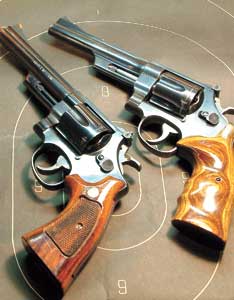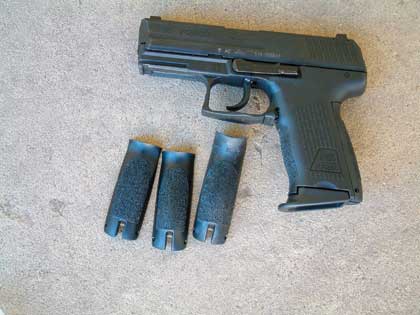How To Determine Hand Size For Pistol Grip

September 24, 2010
Many shooters struggle with guns that are the wrong size for them. Here'southward how to find your perfect fit and experience.
I merely got back from the range, where I instructed a small group of armed guards who were taking part in their first live-fire exercise to determine their fitness to carry guns on duty.

A pair of these gents carried small-scale autoloaders. One of them was a medium-size adult, the other easily a full size larger. While they had some challenges unrelated to the size of the gun, I noted their difficulties in gun handling. Their hands were just as well big for the guns. I recommended something larger for each of them.
That's in stark contrast to a previous situation I've had to face up for many years while instructing firearms in an agency where the issued handguns didn't fit the hands of a significant number of officers. The handguns were steel-frame .45s, double activity the beginning shot, single action for the remaining rounds. The guns were durable, authentic and reliable, but many of us simply couldn't make a fast hit out of the holster--the grip was too deep forepart to back and the trigger attain in double action was mode too long.

Various dimensions of the hand affect handgun fit. It'south not simply long fingers or width of the palm.
And that, in a nutshell, illustrates the trouble of gun fit. There's no blanket solution, no silver bullet, considering of the variety of paw sizes, grip sizes, gun types and situations in which the gun might be used.
Back in the solar day, nosotros carried circular guns instead of foursquare ones. About revolvers were supplied with either wood panel Magna grips on each side of the grip straps or with premium "target" stocks--thicker side to side and lesser to top, and widest where the human being hand has the smallest fingers.
What was our response to these two ill-fitting designs? We changed stocks. The lucky people with small-scale hands--like mine--could take the smaller Magna grips and add a grip adapter to fill the area between the trigger baby-sit and the forepart of the grip frame.
When it comes to handgun fit, everyone assumes yous're talking about grips, but stocks aren't everything. Different size revolver frames can fit certain shooters better than others. Big cylinders take large speedloaders and, for some of us, are slower to manipulate. Tasks related to making the gun work, similar reloading, can be compromised if the gun is also big or as well small.
If you are comfy carrying and using a revolver, life is good. For ane thing, they're available in a wide range of gun sizes. Merely wait at the frame offerings from Smith & Wesson solitary, non to mention the variation in size among unlike manufacturers.
And if there's a gun that you really desire but doesn't fit you exactly right, great-plumbing fixtures culling stocks are available from Hogue, Eagle Grip, Ajax, Herrett's Stocks and Brownell's.
Semiautos are a unlike animal. With them, the gripping surface of the frame is dictated by the size of its magazine, which is, in plow, dictated by the size of the cartridge for which the gun is chambered and the capacity of the magazine.
The 1911 is an instance of an older design with excellent ergonomics. The frame and trigger can be hands inverse to fit the shooter. The original 1911 had a flat mainspring housing and a long trigger. The 1911A1 went to an arched mainspring housing and short trigger.

This Taurus 24/7 Pro is still just a bit big for this woman'southward hand. With the pad of her trigger finger on the face of the trigger, she'south unable to become a proper grip.
If neither the original nor the A1 piece of work for a shooter, messing around with combinations (biconvex housing and long trigger or apartment housing and curt trigger) volition give most users a good fit.
Short stock screw bushings, shortened stock screws and very thin stocks are besides available to minimize the circumference of the gun.
Most double-action autos--properly called "trigger cocking" actions--have triggers with long reaches considering they have to travel a long fashion to fully activate the hammer. And then trigger attain is a big problem with this pattern, as it is with double-action revolvers.

S&West "target" stocks on the Model 29 (left) are too large for about hands. The custom stocks on the South&W Highway Patrolman (right) are thinner, fore and aft and side to side.
This problem is enhanced with autos that utilize double-stack magazines. These high-capacity autos are frequently quite thick with rounded surfaces. And if their stocks are made of wood, information technology makes the whole affair even bigger. The feel of such double-stack, double-action autos is akin to a new bar of soap.
Only as with revolvers, when deciding on a semiauto you should first wait at the overall gun for proper fit. And you'll want to try out equally many models as possible to find 1 you tin work with.
Fortunately, when it comes to today'south designs, there'due south a new paradigm. The firearms manufacture realizes that we aren't all the aforementioned size, and companies have spent considerable amounts of money and fourth dimension ensuring their flagship guns can be adjusted to different shooters--typically through swapping out dissimilar sizes of backstraps or grip thicknesses.
But how do you check the fit? The ordinarily given communication is to make certain (that's doubly sure) the gun is unloaded, point it in a rubber direction so do the following: Concur the gun in the non-firing hand, place the trigger finger of your firing hand on the trigger--locating the distal pad or distal articulation on the trigger face up as you would when firing--then roll your hand back from the trigger and grip the gun. If the muzzle is in line with the basic of the forearm with your finger at its proper location on the trigger, the gun is a fit. If, as the belatedly famed gun fighter Jim Cirillo would say, you're shooting the gun "side-saddle," it's to
o big.
That'southward a elementary check, requiring only a prophylactic backstop to exam the gun fit. Others have measured the circumference of the gripping surface. I always used a cloth tape from the left side of the trigger at the front end, around the left side of the (unloaded!) gun loftier on the backstrap (where your hand should be) and around to the right side of the trigger.
The U.S. war machine service pistol, the M9, measured in at about seven inches around. The previous U.South. pistol, the 1911, measures only under half-dozen½ inches with a long trigger. While a half inch doesn't audio similar much, it makes a big difference.
There are lots of variables beside unproblematic linear measurements. The thickness of the hand and its digits makes a departure. My trigger finger drags on the frame of the Glock. I tin't do anything short of modifying the gun to resolve that. Over a trial of several thousand rounds, I learned to brand do. Many shooters won't do that, and most agencies won't allow that kind of break-in.
Sentinel for the index finger rubbing the side of the frame during dry firing. Also exist aware of your finger dragging on the inside of the trigger guard. Short, thick fingers can wreck trigger command.

The HK P2000 comes with four backstraps, assuasive shooters to adjust for all-time fit.
A terminal quick test for grip fit is to run into if the pad of the pollex of the shooting hand reaches the tip of the middle finger on the left side of the gun (for a right-handed shooter). If information technology doesn't achieve, preferably touching somewhere between the tip of the pollex and the distal articulation, information technology's likely not a good fit. If information technology does reach and the feel is right, you are there.
If you have a baseline of skill with one weapon system, you can cheque gun fit of a new handgun compared to your customary gun by running a few drills.
One I like is the School Drill from the Gunsite 250 Defensive Pistol Class. I take the drill back to 15 yards. I follow up with the Arizona Daytime Qualification Course fired Maricopa County style. Both drills are described in the accompanying charts. Unless you are very familiar with these drills, utilize the times as guidelines only; all you really want to do is run the exercises to get a feel for the handgun.
| Schoolhouse DRILL |
| Starting position: Holstered with gun loaded and charged. USPSA-type target. |
Y'all are looking for ease of attain to necessary controls, gun fit to the mitt (does it feel right?), the speed at which you make the first hit from the holster, and how well yous personally work with the gun.
Practise some dry-fire practice on the range. The first thing to check is reach to the trigger, followed by accomplish to slide finish and accomplish to the mag release push button. You also want to encounter how the forcefulness of the recoil spring affects your ability to rack the slide surely easily while maintaining a firing grip.
Detect your ideal grip on the gun. Holster the gun and replicate the grip with the gun in the holster. Ensure you lot can get a firing grip on the gun while it is holstered.
Which gun is best for you? Endeavour several. Go to a range that rents guns or notice a friend that'southward got a model you'd like to effort. Trying is the but sure manner to find the handgun that fits.
MARICOPA Canton DRILL Nuts
Starting position: Set position or holstered with gun loaded and charged. NRA TQ-21 target.
Stage 1
1. 25 yards, 2 hits from holstered, 6 sec.
ii. 25 yards, ii hits from ready, five sec. (do twice)
Stage 2
1. 3 yards, 3 hits from holster (two middle-mass, 1 caput), strong hand but, iv sec.
2. iii yards, 3 hits from ready (2CM, 1 head), stiff hand only, three sec.
3. 3 yards, 3 hits from holster (2CM, 1 head), two hands, 4 sec.
4. 3 yards, 3 hits from ready (2CM, ane head), ii hands, 3 sec.
v. 3 yards, 2 hits from prepare, weak paw only, iii sec. (practise 3 times)
Stage 3
(starting time with only three rounds in the gun)
i.7 yards, 3 hits from holster, 4 sec.
2. 7 yards, vi hits from ready (3 hits, tactical reload, 3 hits), 15 sec.
three. vii yards, five hits from set up, (three hits, empty reload, 2 hits), 12 sec.
Stage four
1. 15 yards, 3 hits from holster, 5 sec.
2. 15 yards, 3 hits from gear up, four sec.
three. 15 yards, 2 hits from holster, 4 sec. (do twice)
4. 15 yards, 1 hitting from set up, two sec. (exercise twice)
How To Determine Hand Size For Pistol Grip,
Source: https://www.handgunsmag.com/editorial/tactics_training_hg_therightfit_200903/138790
Posted by: hirschthang1994.blogspot.com


0 Response to "How To Determine Hand Size For Pistol Grip"
Post a Comment